Related Research Articles
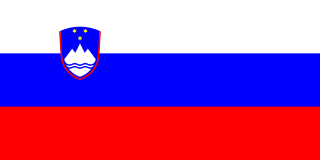
Slovenia, officially the Republic of Slovenia, is a country in southern Central Europe. It is bordered by Italy to the west, Austria to the north, Hungary to the northeast, Croatia to the southeast, and the Adriatic Sea to the southwest. Slovenia is mostly mountainous and forested, covers 20,271 square kilometres (7,827 sq mi), and has a population of 2.1 million. Slovenes constitute over 80% of the country's population. Slovene, a South Slavic language, is the official language. Slovenia has a predominantly temperate continental climate, with the exception of the Slovene Littoral and the Julian Alps. A sub-mediterranean climate reaches to the northern extensions of the Dinaric Alps that traverse the country in a northwest–southeast direction. The Julian Alps in the northwest have an alpine climate. Toward the northeastern Pannonian Basin, a continental climate is more pronounced. Ljubljana, the capital and largest city of Slovenia, is geographically situated near the centre of the country.

Ljubljana is the capital and largest city of Slovenia. It is the country's cultural, educational, economic, political and administrative center.

The national flag of Slovenia features three equal horizontal bands of white (top), blue, and red, with the coat of arms of Slovenia located in the upper hoist side of the flag centred in the white and blue bands. The coat of arms is a shield with the image of Mount Triglav, Slovenia's highest peak, in white against a blue background at the centre; beneath it are two wavy blue lines representing the Adriatic Sea and local rivers, and above it are three six-pointed golden stars arranged in an inverted triangle which are taken from the coat of arms of the Counts of Celje, the great Slovene dynastic house of the late 14th and early 15th centuries.

Krško is a town in eastern Slovenia. It is the seat of the City Municipality of Krško. The town lies on the Sava River and on the northwest edge of the Krško Plain, which is part of the larger Krka Flat. The area is divided between the traditional regions of Styria and Lower Carniola. The entire municipality is now included in the Lower Sava Statistical Region.
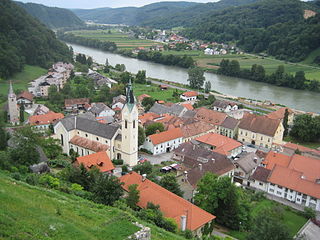
Sevnica is a town on the left bank of the Sava River in central Slovenia. It is the seat of the Municipality of Sevnica. It is one of the three major settlements in the Lower Sava Valley. The old town of Sevnica lies beneath Sevnica Castle, which is perched on top of Castle Hill, while the new part of town stretches along the plain among the hills up the Sava Valley, forming another town core at the confluence of the Sevnična and Sava rivers.

Ljutomer is a town in northeastern Slovenia, 40 km (25 mi) east of Maribor. It is the seat of the Municipality of Ljutomer. Traditionally it was part of the region of Styria. It is now included in the Mura Statistical Region. The economy of Ljutomer is largely based on grape farming and wine making.

St. Peter's Bridge, also Ambrož Bridge, is a bridge in Ljubljana, the capital of Slovenia, that crosses the river Ljubljanica in the northeastern end of the old town. It is a continuation of Rozman Street. West of it lie Vraz Square on the northern (left) bank of the river and Ambrož Square on its southern (right) bank. East of it lies the Petkovšek Embankment on the northern bank and the Poljane Embankment on the southern bank. The bridge is named after the nearby St. Peter's Church. It is intended primarily for motorised traffic, but is also used by pedestrians.
Uršna Sela is a settlement south of Novo Mesto in southeastern Slovenia. The railway line from Ljubljana to Metlika runs through the settlement. The area is part of the traditional region of Lower Carniola and is now included in the Southeast Slovenia Statistical Region.

Črna Vas is a settlement on the right bank of the Ljubljanica River, south of the capital Ljubljana in central Slovenia. It belongs to the City Municipality of Ljubljana. It is part of the traditional region of Lower Carniola and is now included with the rest of the municipality in the Central Slovenia Statistical Region.

Javor is a settlement in central Slovenia. It lies in the hills east of the capital Ljubljana and belongs to the City Municipality of Ljubljana. It is part of the traditional region of Lower Carniola and is now included, with the rest of the municipality, in the Central Slovenia Statistical Region. In addition to the main settlement, it also includes the hamlets of Brezovar, Lanišče, Roje, Žagarski Vrh, Zavrharji, and Sevšek.

Sts. Cyril and Methodius Church, commonly known as the Orthodox Church, is an Eastern Orthodox church building located in Trubar Park, between Bleiweis Street and Prešeren Street, north of the Museum of Modern Art and west of the National Gallery of Slovenia. It belongs to the Metropolitanate of Zagreb and Ljubljana of the Serbian Orthodox Church.
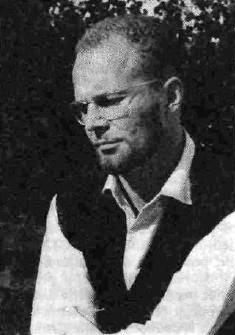
Andrej Hieng was a Slovene writer, playwright and theatre director.

Milan Jesih is a Slovene poet, playwright, and translator. He was the president of the Slovene Writers' Association between 2009 and 2011.
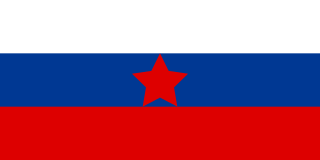
The Slovene Partisans, formally the National Liberation Army and Partisan Detachments of Slovenia, were part of Europe's most effective anti-Nazi resistance movement led by Yugoslav revolutionary communists during World War II, the Yugoslav Partisans. Since a quarter of Slovene ethnic territory and approximately 327,000 out of total population of 1.3 million Slovenes were subjected to forced Italianization since the end of the First World War, the objective of the movement was the establishment of the state of Slovenes that would include the majority of Slovenes within a socialist Yugoslav federation in the postwar period.
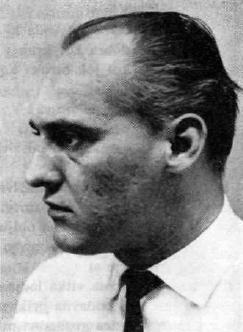
Ivan Minatti was a Slovene poet, translator, and editor. He started writing poetry before World War II, but principally belongs to the first postwar generation of Slovene poets. He is one of the best representatives of Slovene Intimism.

Marija Lucija Stupica was a Slovene children's book illustrator.
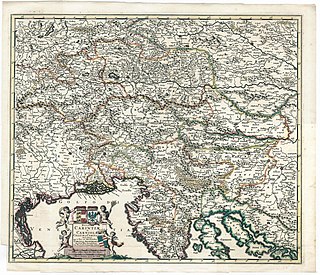
World War II in the Slovene Lands started in April 1941 and lasted until May 1945. The Slovene Lands were in a unique situation during World War II in Europe. In addition to being trisected, a fate that also befell Greece, Drava Banovina was the only region that experienced a further step — absorption and annexation into neighboring Nazi Germany, Fascist Italy, and Hungary. The Slovene-settled territory was divided largely between Nazi Germany and the Kingdom of Italy, with smaller territories occupied and annexed by Hungary and the Independent State of Croatia.
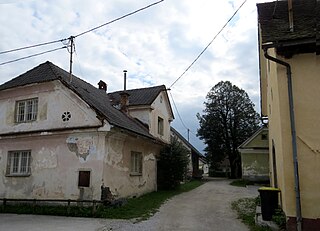
Kozarje is a formerly independent settlement in the western part of the capital Ljubljana in central Slovenia. It is part of the traditional region of Upper Carniola and is now included with the rest of the municipality in the Central Slovenia Statistical Region. It includes the hamlet of Žeje.

Koseze is a formerly independent settlement in the northwest part of the capital Ljubljana in central Slovenia. It is part of the traditional region of Upper Carniola and is now included with the rest of the municipality in the Central Slovenia Statistical Region.

Rožna Dolina is a formerly independent settlement in the southwest part of the capital Ljubljana in central Slovenia. It is part of the traditional region of Upper Carniola and is now included with the rest of the municipality in the Central Slovenia Statistical Region.